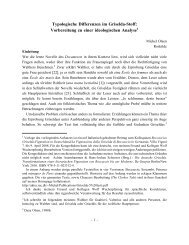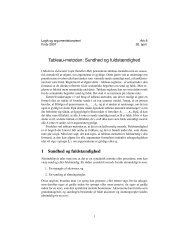Large–Scale Urban Development Projects and the New Urban Policy
Large–Scale Urban Development Projects and the New Urban Policy
Large–Scale Urban Development Projects and the New Urban Policy
You also want an ePaper? Increase the reach of your titles
YUMPU automatically turns print PDFs into web optimized ePapers that Google loves.
Neoliberal <strong>Urban</strong>ization in Europe 569<br />
Table 5: Continued<br />
Project<br />
Real-Estate Market, <strong>the</strong> Production of Rent,<br />
<strong>and</strong> <strong>the</strong> <strong>Development</strong> of <strong>the</strong> UDP<br />
Copenhagen In general, <strong>the</strong> prices in <strong>the</strong> housing market skyrocketed during<br />
Orestaden <strong>the</strong> second half of <strong>the</strong> 1990s <strong>and</strong> <strong>the</strong> social geography within <strong>the</strong><br />
city has become more polarized. There still exists an important<br />
social-housing sector, but <strong>the</strong> role of this sector has gradually<br />
declined, because housing construction subsidized by <strong>the</strong><br />
municipality <strong>and</strong> <strong>the</strong> state has almost stopped since <strong>the</strong><br />
beginning of <strong>the</strong> nineties. The municipal housing policy has<br />
increasingly been used as a tool to regulate <strong>the</strong> tax base of<br />
Copenhagen, favoring <strong>the</strong> middle classes. The UDP follows<br />
this trend.<br />
Lille<br />
Euralille <strong>and</strong> o<strong>the</strong>r UDPs in <strong>the</strong> Lille agglomeration did not<br />
Euralille lead to skyrocketing increases of l<strong>and</strong> <strong>and</strong> housing prices.<br />
However, inside <strong>the</strong> agglomeration, real-estate market<br />
dynamics have produced a displacement of lower-middle-class<br />
<strong>and</strong> working-class population to “cheaper” areas. Gentrification<br />
projects in particular (first Vieux Lille, <strong>the</strong>n Euralille,<br />
Wazemmes, <strong>and</strong> Moulins) with more offices, exquisite services,<br />
<strong>and</strong> middle- to upper-class housing estates, led to local price<br />
rises, driving deprived population groups to o<strong>the</strong>r<br />
neighborhoods, especially to <strong>the</strong> south of Lille or even outside<br />
<strong>the</strong> agglomeration. The UDP has contributed to this growing<br />
spatial differentiation of real-estate <strong>and</strong> rental values.<br />
Vienna Rents skyrocketed in <strong>the</strong> second half of <strong>the</strong> 1980s <strong>and</strong> have<br />
Donau-City been stagnating since <strong>the</strong>n. This can be explained by a<br />
contradictory movement. On <strong>the</strong> one h<strong>and</strong>, <strong>the</strong>re still exists an<br />
important public-housing sector. Housing construction<br />
subsidized by <strong>the</strong> municipality was intensive until 1996, <strong>and</strong><br />
restrictive rent laws were applied until 1982. On <strong>the</strong> o<strong>the</strong>r h<strong>and</strong>,<br />
liberal regulation is advancing: subsidies for construction of<br />
housing have been dramatically reduced over <strong>the</strong> last years.<br />
Fur<strong>the</strong>rmore, publicly subsidized housing is increasingly<br />
oriented towards <strong>the</strong> upper middle classes. The UDP is a<br />
paradigmatic case illustrating <strong>the</strong>se changes.<br />
Naples During <strong>the</strong> 1980s, prices in <strong>the</strong> real-estate market grew<br />
Centro dramatically to reach record levels in 1991 <strong>and</strong> 1992,<br />
Direzionale particularly in selected central areas. They subsequently<br />
declined almost as fast as <strong>the</strong>y had previously risen, continuing<br />
to fall until 1997, when <strong>the</strong> first signs of recovery appeared <strong>and</strong><br />
prices stabilized or began to increase again. Apartments in <strong>the</strong><br />
Centro Direzionale di Napoli (CDN) became available at <strong>the</strong><br />
peak of <strong>the</strong> market price for prime location units <strong>and</strong> thus could<br />
be expected to yield quite significant returns. The developer,<br />
however, sold 90% of <strong>the</strong> residential units to a state-run<br />
pension fund for <strong>the</strong> employees of public companies <strong>and</strong><br />
guaranteed his return. By law, only families working for state<br />
agencies are entitled to rent those apartments, <strong>and</strong> rental prices<br />
are set lower than <strong>the</strong> market price according to <strong>the</strong> rules of <strong>the</strong>
















